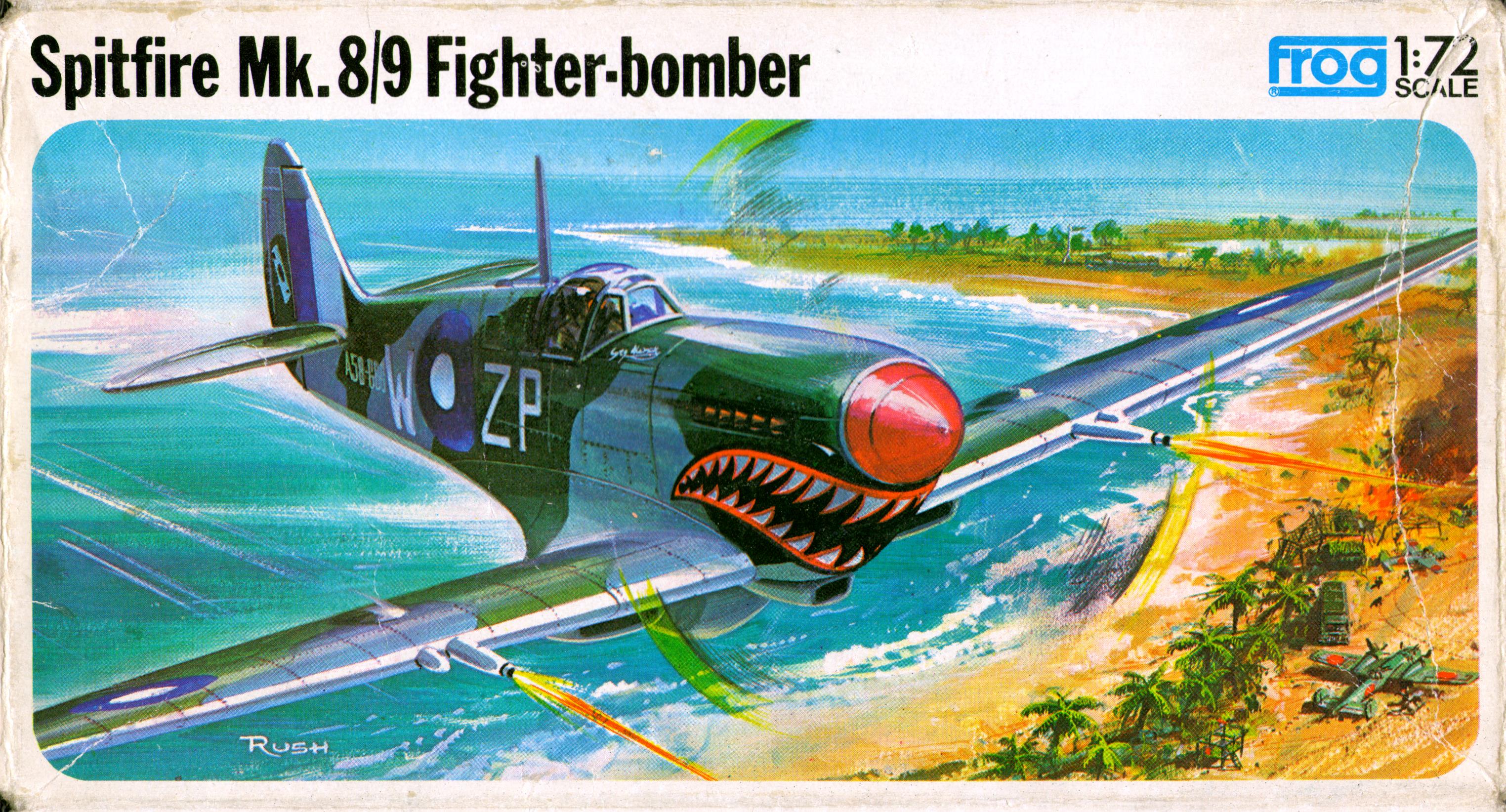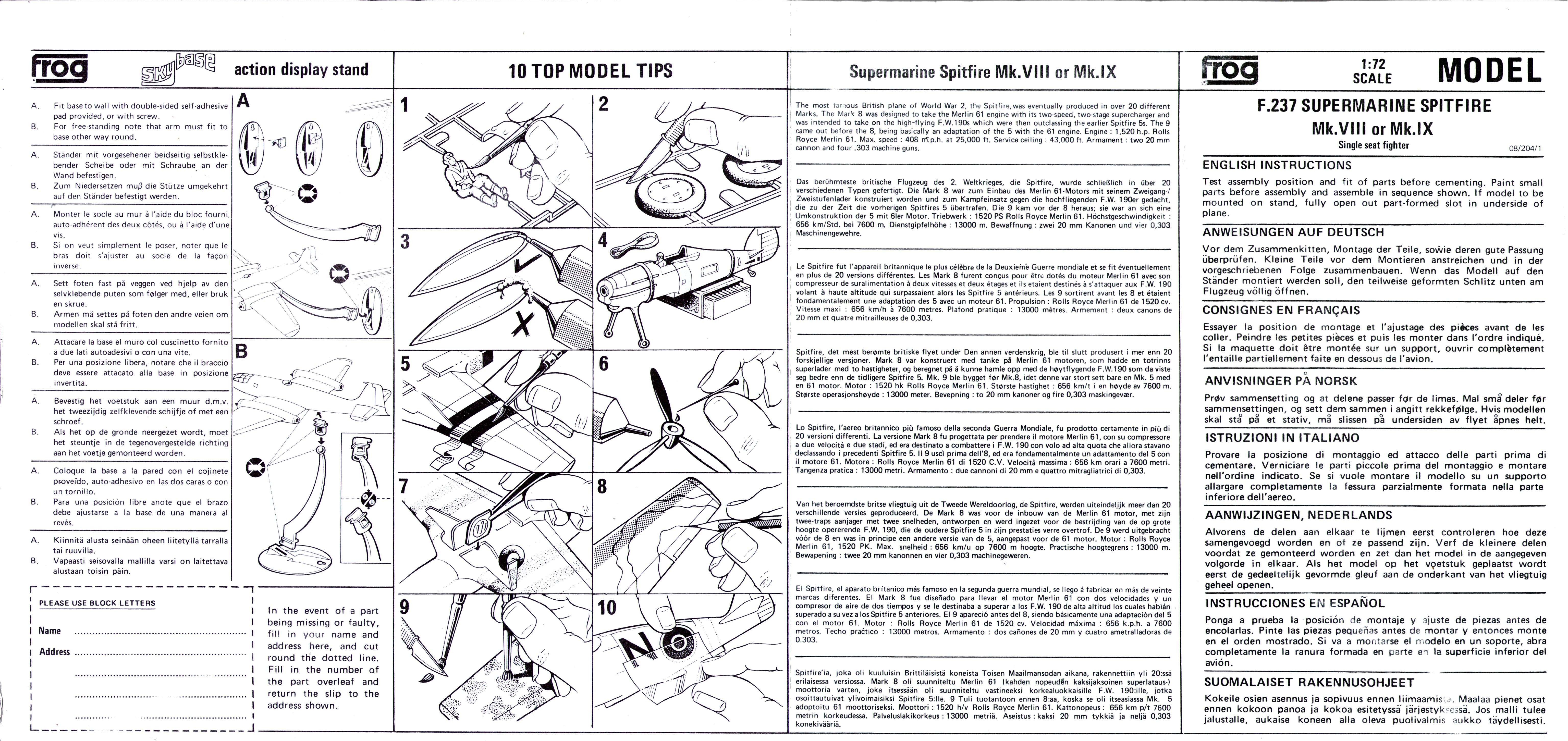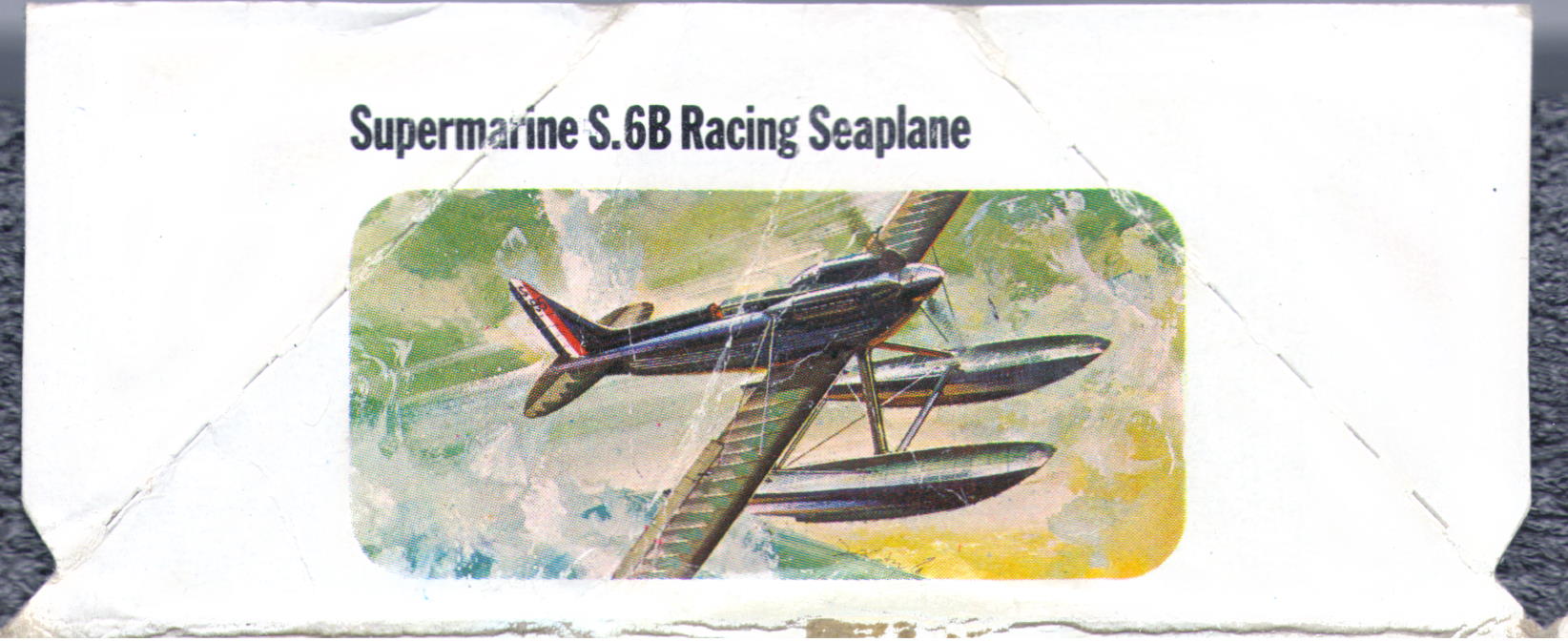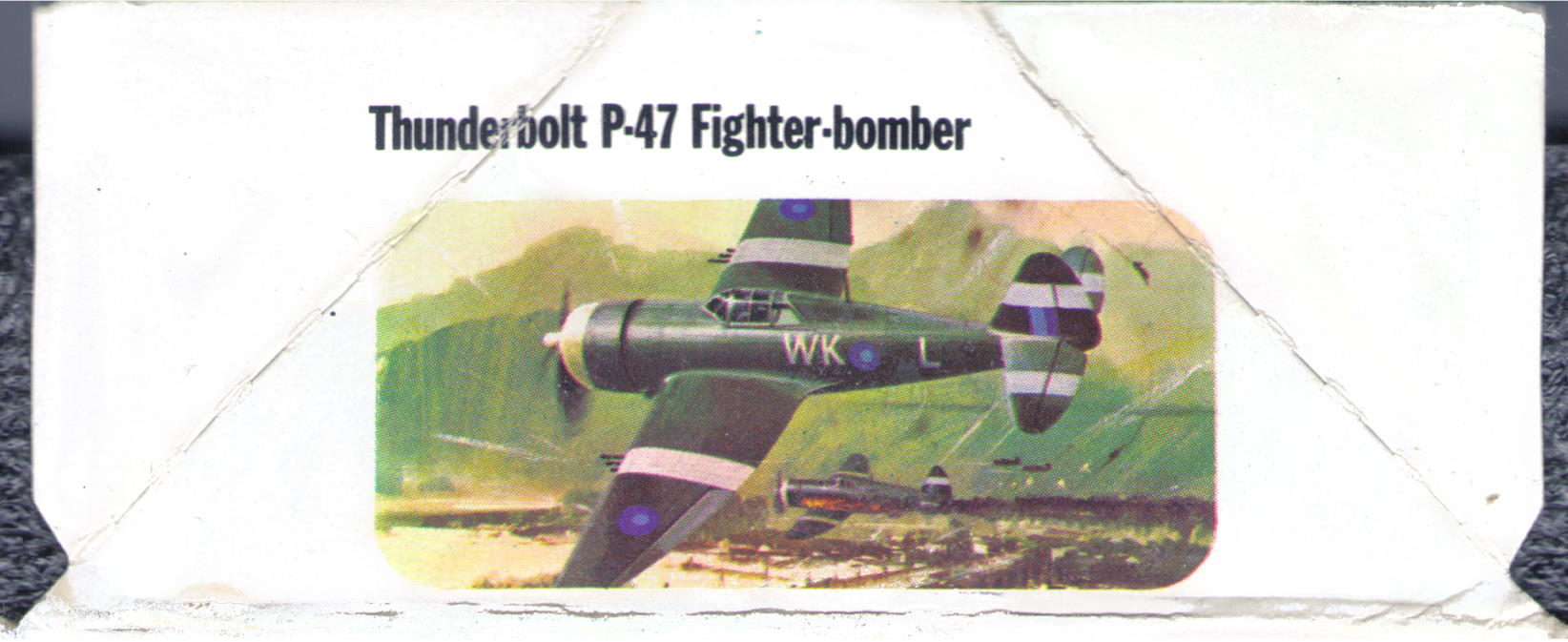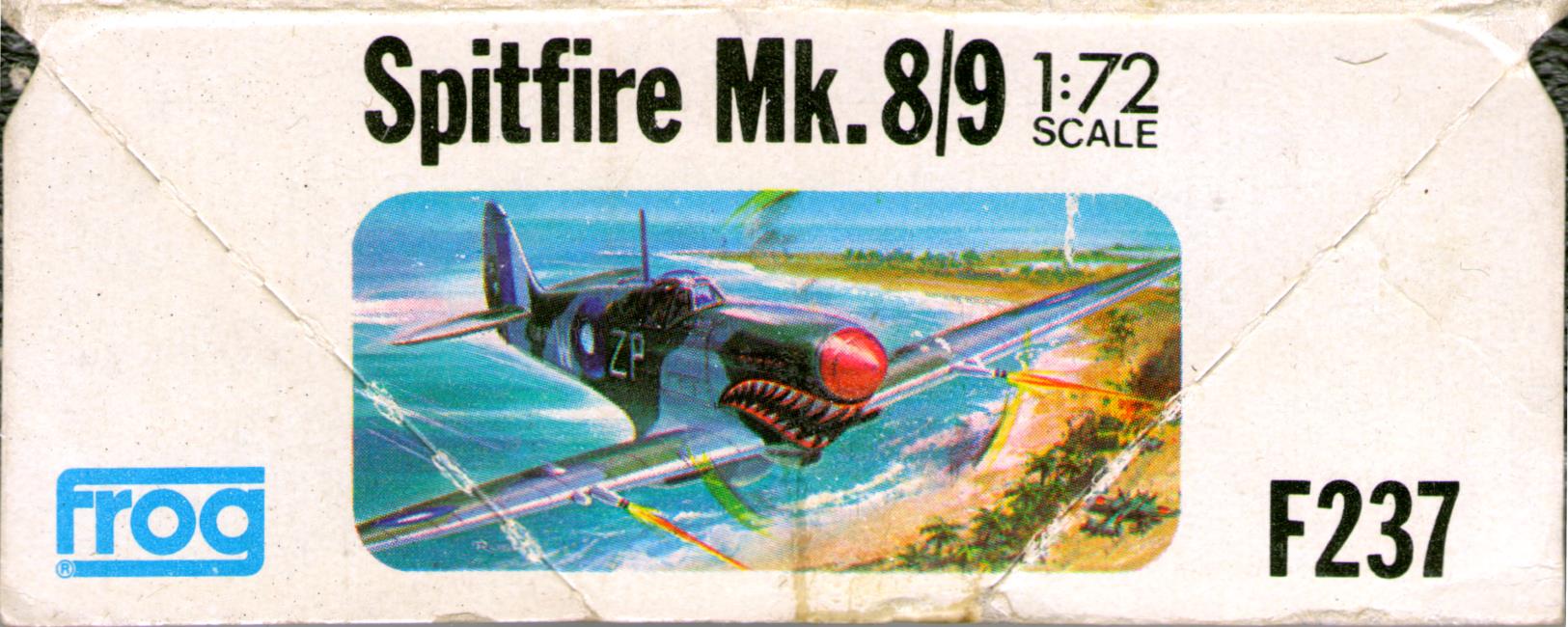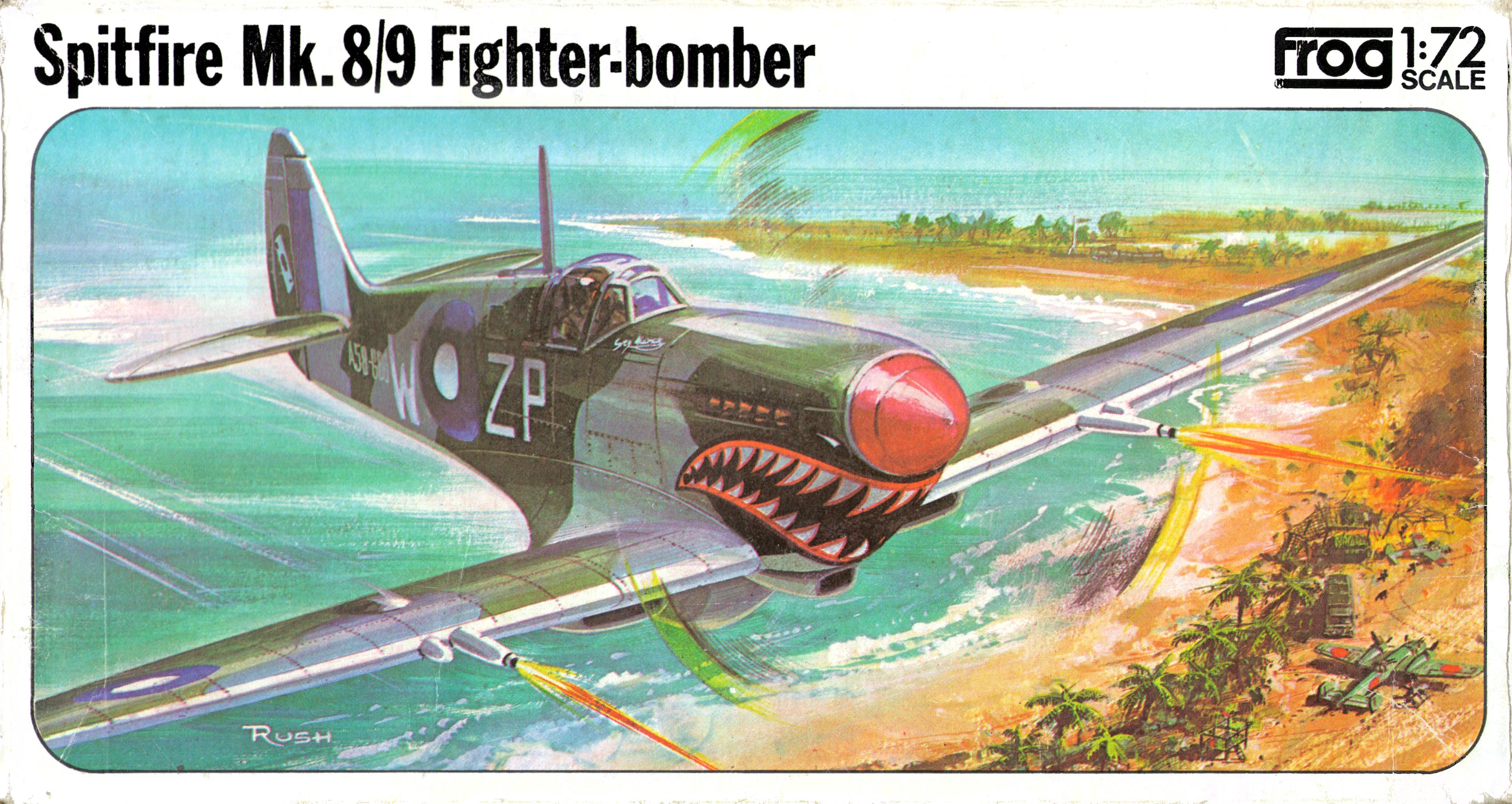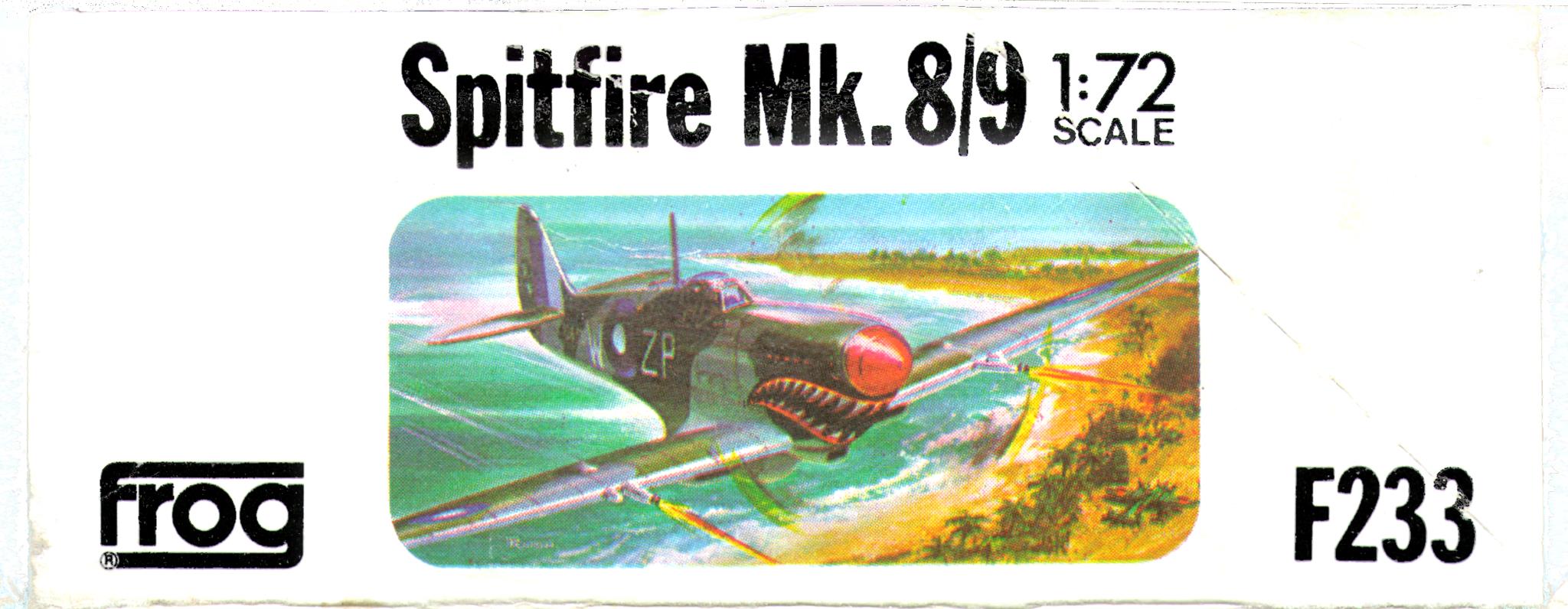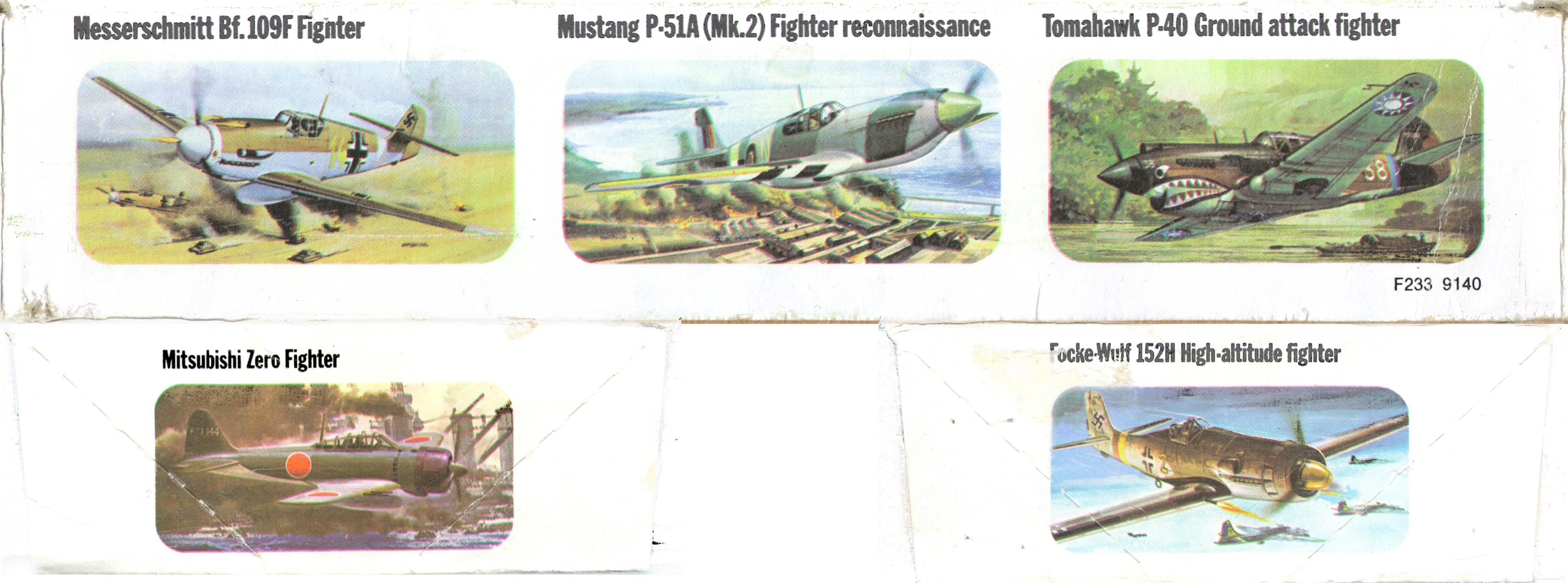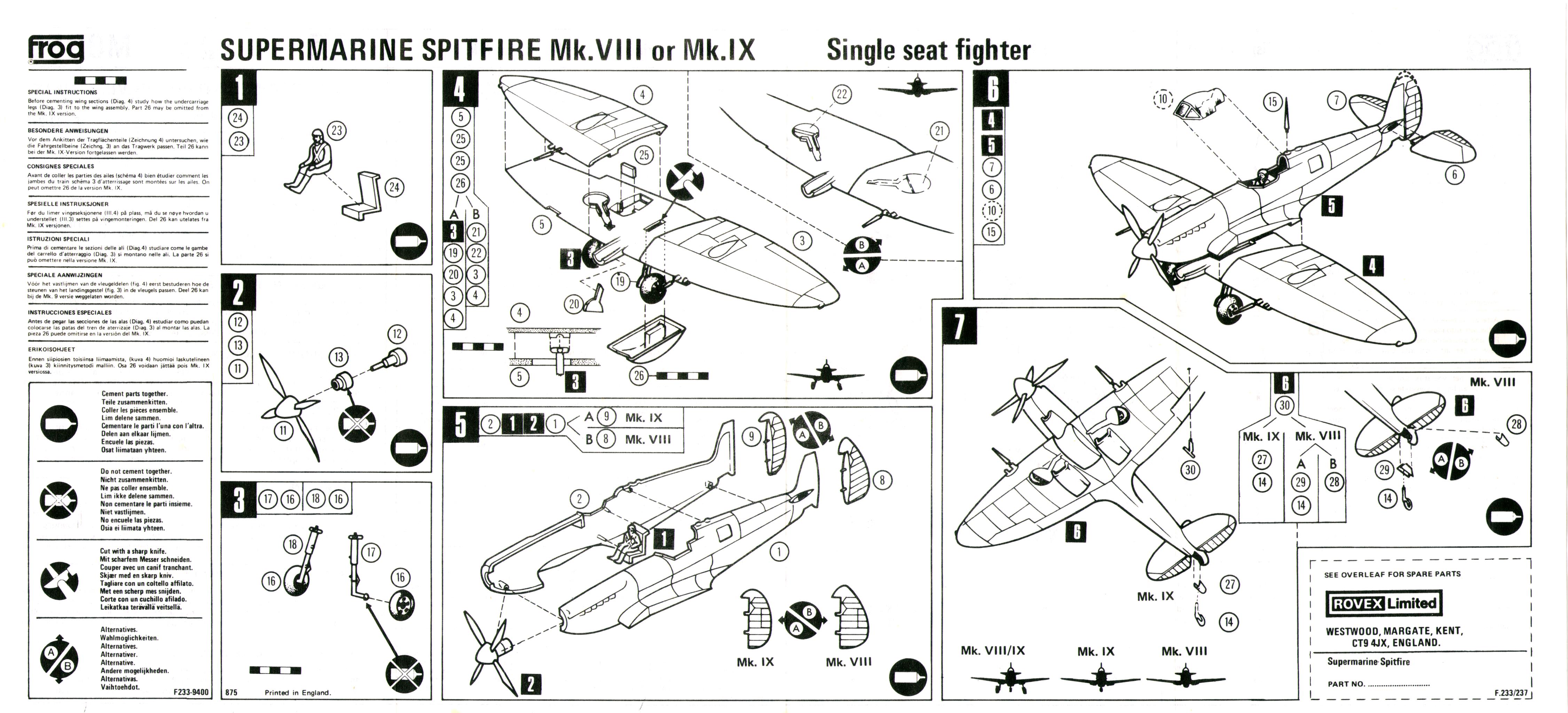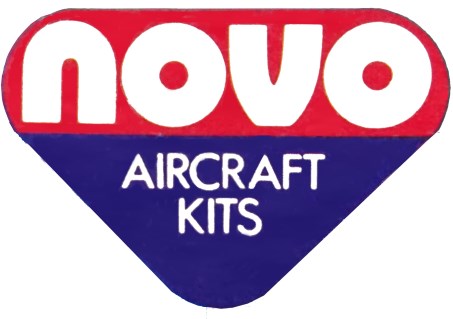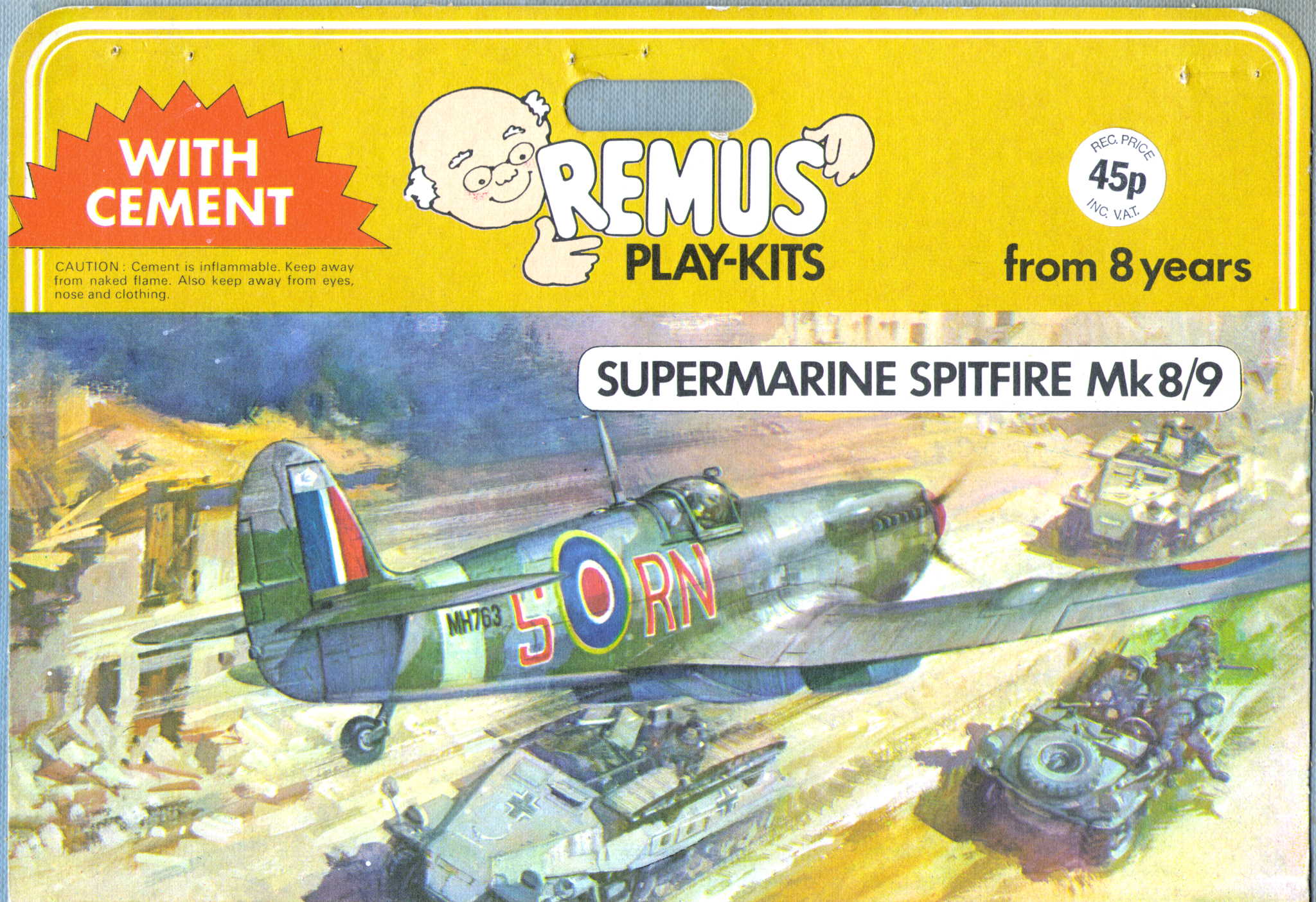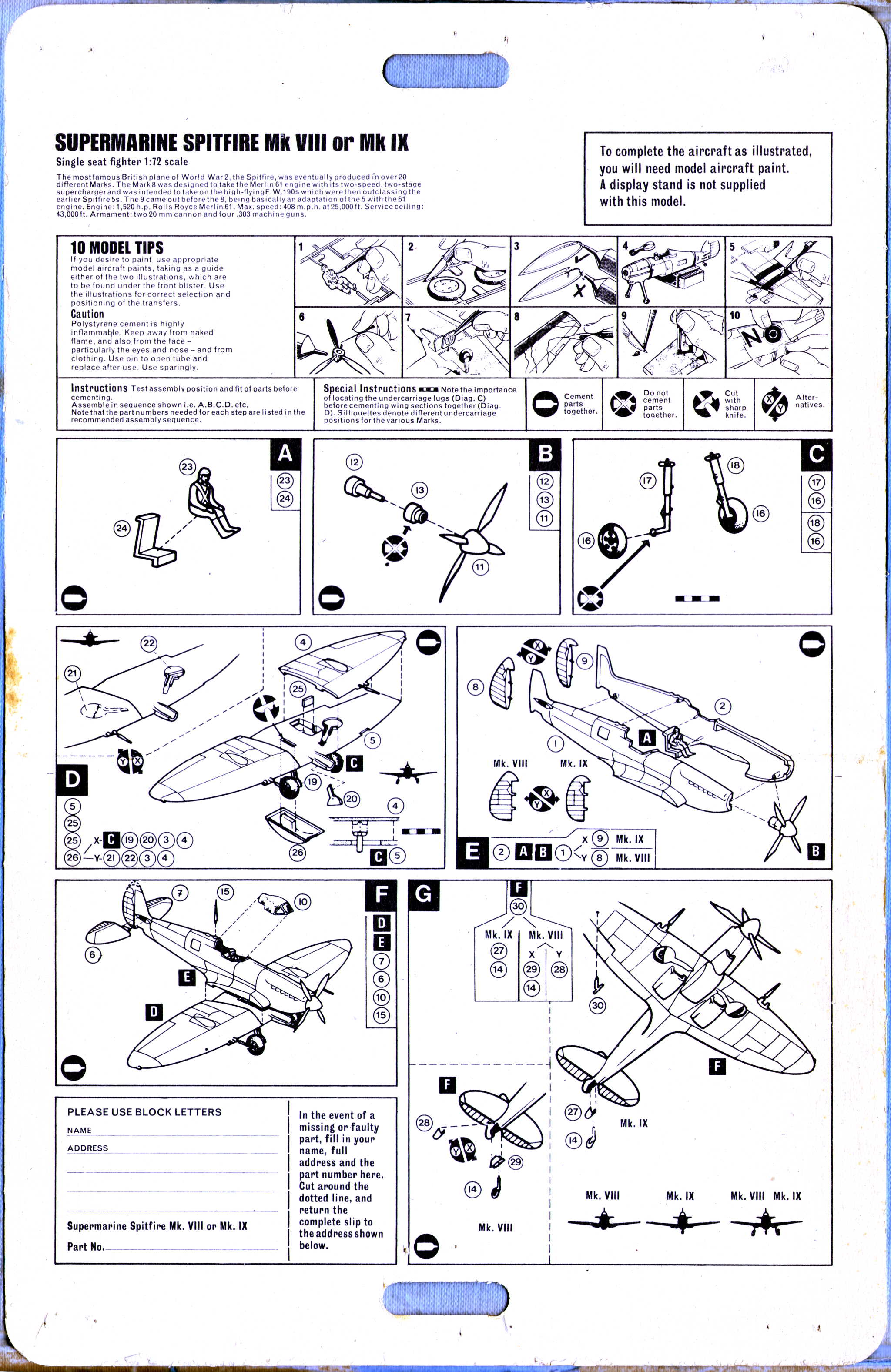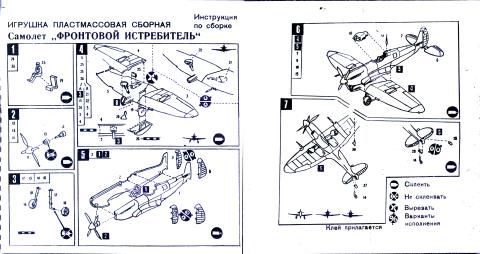Aircraft Illustrated 1974-12
Modelling world
James Goulding
New Spitfire from Frog
Frog has now issued a 1/72 Spitfire VIII or IX kit to augment its old Spitfire I. Unfortunately the prefect 1/72 'Spit' has again eluded us, because fairly drastic mods are required on this model to produce that true Spit character.
In plan view and side view this model is closer than any yet in this scale to the true shape. The fuselage shape is also better, although it could be improved by a slight sharpening of the fuselage top where it fairs into the fin. It is the wing, however, that lets this model down — not because of plan form, which is excellent, but because head-on taper is insufficient down to the tip and the aerofoil sections are not the true shape. A feature of the Spitfire wing was its unusual thinness -particularly at the tip. It had a thickness/ chord ratio (ie proportion of wing depth to width, from leading to trailing edge, at the root and only 8 per cent at the tip. Even high speed types such as the Meteor, Vampire and Hornet had thicker sections at the tip and it was mainly this aerodynamic refinement that permitted Spitfires under test conditions to be dived at over Mach 0.9, which was higher than could be attained by either the Meteor or Vampire. Under comparitive tests the Spitfire was found to be capable of higher Mach numbers than the Mustang in spite of the latter's special laminar flow wing, with the drag rise due to compressibility effects occurring much earlier on the North American fighter.
Any model of the spitfire, then, must highlight this characteristic of an advanced, thin wing, with an aerofoil section which was less rounded and blunt than on most contemporary sections. The wing on the Frog model can be improved by filing down the mating surfaces, especially towards the tips, and by filing the upper surfaces in the same region. The mating surfaces can be filed before cementing and the protruding undersurface of the tip can then be filed to match. The upper surfaces around the tip can be filed to thin the taper and sharpen the leading edges of the aerofoil sections, although this will of course en-' tail some loss of surface detail. Where the upper surface has been filed some replacement detail could be scored to indicate such items as the machine gun access doors and wing tip joint.
Separate parts are provided to allow either a Mk VIII or Mk IX to be made although, strictly speaking, this is not possible unless different wings are provided. The major differences between the Mk VIII and Mk IX externally were that the VIII had a rectractable tailwheel and revised, shorter-span ailerons. The kit provides a choice of non-retractable and retractable tail wheels, but modellers must make their own alterations to the ailerons if the Mk VIII is their choice - by scoring a new aileron gap 1/8 inch inboard of the existing engraved line, which must be filled and smoothed over.
Two rudders are supplied in the kit, the standard original type and the broader chord, pointed type. The latter was standard on the Mk VIII and became standard eventually on late production Mk IXs.
The long-range ventral slipper tank is included in the kit. Transfers are provided for a Spitfire IXC of 72 Squadron flown by Fit Lt Prince Emanuel Galatzine during the invasion of Southern France, and a Mk VIII flown by Sqn Ldr Bruce Watson, CO of 457 Squadron, RAAF, in the South-West Pacific Area. This aircraft has distinctive "shark's teeth" markings, as did most, if not all, the Squadron's aircraft. These markings varied from one Spitfire to another, and the one on the decal sheet is a little larger than it should be on Sqn Ldr Watson's aircraft, and is closer to one of the larger versions of the marking. The code and aircraft letters should be somewhat thinner.
Although not the perfect 1/72 Spitfire, this is a model that can be made, with modifications, into one of the best to date. It can form a good basis for other variants, namely the Mk VII, PR Mk XI, two-seat trainer, and Mk XVI. Price of Frog's Spit VIII/IX kit is 40p.
We are shortly to have a Mk V from another manufacturer: perhaps that will be the elusive "perfect" Spitfire!
AIRCRAFT ILLUSTRATED 1974-12
Modelling world
James Goulding
Frog's Spitfire Mk VIII
in my review of Frog's new Spitfire VIII kit in the Decmber 1974 issue I stated that the "shark's teeth" marking on Squadron Leader Bruce Watson's aircraft ZP-W was too large. In fact, I was quite wrong: his aircraft was at different times adorned with "shark's teeth" in both large and small forms, and Frog's markings quite correctly show the Spitfire with the larger form (possibly re-painted to make them look fiercer!) My apologies to Frog for doubting the accuracy of their decals, which are usually of a very high standard.
In the same article, during printing, a sentence was omitted which gave the Spitfire's wing root thickness/cord ratio as 13 per cent.
AIRCRAFT ILLUSTRATED 1975-02
WARBIRDS Kits Review
Bob Jones reviews the latest 1:72 scale 'Spit'
FROG SPITFIRE VIII/IX
PERHAPS the best known and certainly the most prolific of all Spitfire variants the Mk. IX (not Mk.9 as Supermarine used Roman numerals for type numbers up to XX, not arabic style!) has been poorly covered by the kit manufacturers, particularly in the popular 1/72 scale. Apart from the now somewhat aged Airfix Mk IX and the more recent Matchbox kit the modeller had no other kits from which to choose.
It was hoped that the Frog kit recently released in UK would help fill this gap. Having now studied the review sample we feel that they would have done better to offer this kit specifically as a Mk. IX OR as a Mk. VIII and not endeavour to offer more for the money by the combination of parts however good the idea may seem to be.
Basically the outline shape of the fuselage, wings, tailplanes etc. are accurate but the kit does fall down in regard to details.
For example, the fuselage mouldings represent that for a Mk. VIII complete with provision for the retractable tailwheel etc., but the wing mouldings are of the Type 'C wing of the Mk. IXc which differed from those of the Mk. VIII by having the standard rather than shortened length ailerons. Thus to be pedantic, if one completes the kit as a Mk. VIII then one would have to fill the outer edge to the ailerons (as we did) and recut new join lines further inboard. Rather unfortunately the long type Aero-Vee carburettor filter fairing common to the Mk.s VIII/IXc and later XIV's is moulded integrally with the lower wing mouldings, i.e. separate from the fuselage and because of the difficulty in obtaining sufficient draw in the tool the cross section of the intake fairing is not correct. This results in a rather unfamiliar outline to the profile of the lower engine cowling, and incidentally, a low leading edge position.
The spinner on our sample suffered from sinkage in the moulding but otherwise appears to be accurate in shape and section as are the propeller blades moulded integrally.
The cockpit canopy is rather thick and heavy and surprisingly Frog have misinterpreted the frame/fairing detail for the pilot's windshield. On the full size machine there was a fairing plate attaching to the fuselage onto which the lower edges of the windscreen mated. However, for some (oxyge unexplained reason, Frog mould this fairing as part of the main fuselage and then repeat the lower framework on the lower edge of the canopy moulding giving the cockpit a rather bulky and unrealistic profile.
Cockpit interior detail is limited to a very simple 'L' shaped platform on which the pilot figure 'sits' and surprisingly there is no attempt to represent the distinctive headrest/ back armour so'dearly part of the cockpit interior of any Spitfire.
Optional parts in the kit include the standard IXc rudder together with the larger area 'pointed' rudder as for the Mk. VIII Also included-and very useful too (as a separate moulding) is a 30 gallon belly tank. The undercarriage legs are really incorrect as they include a small triangular projection obviously supposedly representing the torque links but the Dowty undercarriage on all Spitfires did not carry this type of lower leg location. Really with so many full size Spitfires available for study in the UK this error is really remarkable!
Surface detailing on all the mouldings consists mainly of raised lines except of course for the hinge lines on rudder, tailplanes and mainplane.
Decals are excellent and include a veritable mass of underwing and other stencil instructions which are so much a par, of the external appearance of any Spitfire. Markings are provided for a Mk. IXc flown by F/Lt. the Prince Emanuel Galatzine of 72 Squadron RAF, August 1944 with the markings for the Mk. VIII those of S/Ldr. Bruce Watson, CO. of 457 Squadron Royal Australian Air Force, Morotai Island, South West Pacific early 1945, the latter being the famous 'Grey Nurse' sharkmouth Squadron the full markings for which are included in the kit decals, although the mouth is incorrectly drawn on the box art.
Doubtless the younger modeller may be satisfied to make the kit 'from the box' but for anyone wishing to produce a really detailed representation of a Mk. VIII or Mk. IXc then we suggest that one obtains a copy of the M.A.P. Spitfire Plan Pack 2740 (price 27p) - drawings originally appeared in AEROMODELLER for December 1960 - which covers the Mk.s VI11 and IX variants plus the XVI.
Summing up
A good effort on the part of Frog to cater for those modellers who often ask for optional parts or provision for optional variants all in the same kit. We feel it would have been preferable to have simply made the kit as a 'straight' Mk. VIII or Mk. IXc or even the Mk. XVI. For 40p, the kit gives the keen moderler something to get his scalpel into if he wants to add the famous fighter to his collection.
R.C.J.
Scale Models Vol. 6, No. 64 January 1975
Scale Mail
Spitfire undercarriage
Dear Sir,
I have been an avid reader of Scale Models for the last 4 years or so, and find it an excellent magazine on all subjects of scale modelling, especially aircraft. I have just finished reading your review on the new FROG Spitfire VIII/IX kit, and I wonder if you could clear up a couple of points which have been puzzling me about the Spitfire VIII undercarriage legs. In your review the writer takes FROG to task because the undercarriage legs are obviously incorrect as they include a small triangular projection, supposed to be a torque link.
I have been told by a fellow enthusiast who is at present restoring a Spitfire VC at Panafield Aerodrome (near Adelaide) that the Spitfire VIM had torque links on its U/C legs. I have also returned to some of "Kookaburra Technical Publications" books, and in particular I would ask you to look at the cover photo on "Warplanes of the RAAF, fighters 1921-69, which shows ZP-W (Grey Nurse) on ops. in the Halmaheras in 1945, and see if you can see an object just above the tyre on the port U/C leg. Does this not look very much like a torque link? If it is not, maybe some reader can explain its function.
In the text of MAP planpack 2740 it is stated that two Vickers cantilever oleo-pneumatic shock absorber legs are used on the Mks VII, VIII, XI and XVI Spitfire, not Dowty legs. The last remark in column 3 of the review states that with so many Spitfires available for study in the UK this error is really remarkable. I checked the list of Spitfires in MAP-HARLEYFORD "Spitfire" by Bruce Robertson, and it only lists 4 Spitfire Vlll's in the World as in May 1973, and only 1 is in the UK, at RAF Andover, N32, G-AIDN so this is not so many MK Vlll's to check from. So I think your reviewer should get his facts straight before he commits himself to print, and criticises a kit manufacturer's components too much.
I really enjoy the magazine though, and I hope you will not take this as a brickbat but I would like to find out if a Mk VIII Spitfire had torque links or not.
South Australia
John Schrader
Bob Jones replies:
In reply to this letter from John Schrader I duly don sackcloth and ashes and admit that by dogmatically claiming that all Spitfire Vlll's did not carry torque linkages I am in error.
Such links ARE clearly visible in the photograph on the cover of Warplanes of the RAAF. BUT if one looks at the photograph top of page 21 of Spitfire Markings of the RAAF Part 2 (also by Kookaburra Technical Publications) this shows another Mk VIII A58-457 ZP-Z WITHOUT torque linkages.
The Spitfire VIII ex-MT818 converted to a two seat trainer originally marked N32 and now registered as G-AIDN also lacks these linkages.
A telephone call to a source at Dowty resulted in further confusion as they quoted several other Spitfire photographs showing Mk Vlll's both with and without such linkages.
If one refers to the 1/72 scale drawings of the Mk VIII featured with my kit review Scale Models, January 1975 issue it will be seen that these drawings also omit the torque linkages. G. R. Duval who originated these drawings flew Mk Vlll's and the quality of accuracy and detail on these and also many other drawings suggest that it is very unlikely that the artist would not have checked his reference sources down to the last detail including torque linkages if relevant.
R.C.J.
Scale Models Vol. 6, No. 70 July 1975
Air Enthusiast 1975-02 vol.08 no.02
MODEL ENTHUSIAST
A contrasting pair from Frog
If not exactly flooding the stockists with new releases, Rovex is at least working its way steadily through the kits announced in its current Frog catalogue, and the latest to be received for 'processing' on our workbench consist of one entirely new kit and a modified re-issue, both to 1/72nd scale.
The new kit is for the Supermarine Spitfire and may be assembled as either a Mk VIII or the more numerous Mk IX, and we welcome it as undoubtedly the best Spitfire kit to this scale yet.
We have been unable to fault it anywhere as regards outline accuracy and the component parts assemble well, although we must voice our oft-repeated complaint concerning lack of cockpit detail.
Alternative rudders are included in the kit, both being applicable to either mark, there being little to distinguish them externally except for the retractable tail-wheel and tropical filters of the Mk VIII.
An interesting additional item is the long-range under-fuselage 'slipper' tank which was employed for ferrying.
The most attractive decal sheet covers a Mk IX of No 72 Sqdn, RAF, in Southern France, August 1944, and a Mk VIII of No 457 Sqdn, RAAF, operating from Morotai Island, SW Pacific, early in 1945.
Introduction of the necessary cockpit interior detail should not present a major problem, and any modeller worthy of the name should be able to produce a really convincing Spitfire from this kit, which is priced in the UK at 40p.
The other Frog offering is the Vickers Vimy Mk IV bomber, the kit having first appeared some time ago as one of the "Trail Blazers" series and originally depicting Alcock and Brown's trans-Atlantic machine of 1919.
The kit, as now revised, has been given guns, bomb racks and bombs to turn it into the standard bomber version.
The vertical bomb-aiming windows, clearly depicted by the boxtop illustration, have not been incorporated in the kit, however, being represented only by black transfers on the decal sheet.
Fortunately, it is not too difficult a job to cut the openings and insert pieces of clear plastic.
The two machines for which decals are provided are a silver-finished example from No 70 (B) Sqdn, based at Heliopolis, Egypt, in 1921, and an aircraft employed by the RAE Farnborough around the same period sporting chocolate brown upper surfaces and sides and clear-doped undersurfaces.
These form a nice contrast and the decals provide the appropriate roundels for the period in the correct colour shades.
The UK retail price of this kit is 70p.
F J HENDERSON
Air Enthusiast 1975-02 vol.08 no.02
|
